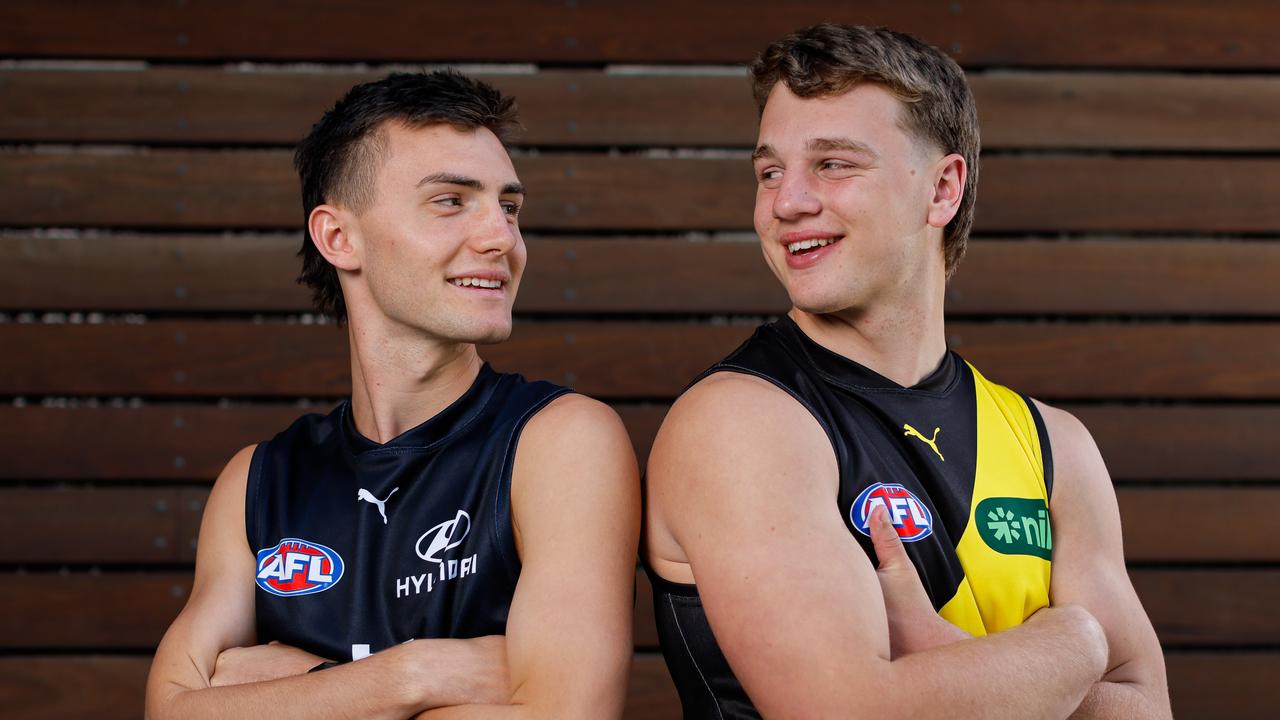Everything you need to know about the AFL draft from live trading to the bidding process as the next generation arrives

- by Admin
- November 18, 2024
The games may be in the books in the AFL season with the Brisbane Lions having won this year’s premiership, but that does not mean the action stops.
After a frantic end to this year’s trade period, all 18 clubs have another opportunity to add to their respective lists in the national draft.
While the draft is an annual event in the AFL calendar, it can often prove to be confusing to follow, so we’ve got you covered with all the biggest questions.
When is the AFL draft?
This year’s national draft will run across two separate nights.
The first round will be on Wednesday, November 20.
The remainder will take place on Thursday, November 21.
What time is the AFL draft?
Both nights of the draft will start at 7pm AEDT.
Here are the corresponding times for other regions of Australia.
- 6:30pm ACDT: South Australia
- 6pm AEST: Queensland
- 5:30pm ACST: Northern Territory
- 4pm AWST: Western Australia
How can fans follow this year’s draft?
ABC Sport will have live blogs running on both nights of the draft.
Fans wanting to watch it can do so on Fox Footy and Kayo Sports.
The AFL draft will be held on November 20 and 21. Check out our full top 30 rankings here, and join us for our live blog on draft nights.
Who has the first pick in this year’s draft?
After finishing the 2024 season at the bottom of the ladder, Richmond will have the first pick in the draft.
It is the first time the Tigers are making the first overall selection in the draft since 2004, when they selected Brett Deledio.
Who are the players in line for the first pick?
This year’s first round is thought to be one of the more even draft crops in recent years, meaning a number of players are in line to be taken with the first pick.
Levi Ashcroft is widely thought to be one of the top players in the draft, but he will head to Brisbane under the father-son rule.
Vic Country midfielder Sam Lalor has emerged as the other leading contender to be taken first overall, earning comparisons to recently retired Richmond great Dustin Martin.
Other players in the running to have their names called at the top of the draft are South Australian midfielder Sid Draper, and Victorian midfielders Jagga Smith and Finn O’Sullivan.
Sam Lalor is in the running to be taken first overall by Richmond in this year’s draft. (AAP: Joel Carrett)
What is the current order of picks in this year’s first round?
- Richmond
- North Melbourne
- Carlton
- Adelaide
- Melbourne
- Richmond
- St Kilda
- St Kilda
- Melbourne
- Richmond
- Richmond
- West Coast
- Port Adelaide
- Fremantle
- GWS Giants
- GWS Giants
- Western Bulldogs
- Richmond
- Sydney
- Richmond
- GWS Giants
- Sydney
- Richmond
Richmond could use up to eight picks in the first round to jump start its rebuild after the retirement of Dustin Martin this year. (AAP: Joel Carrett)
How does the AFL determine how many first-round picks there are?
Typically, each round of the AFL draft should have 18 selections, one corresponding to each team.
However, sometimes compensation picks awarded by the AFL can extend certain rounds out.
This is the reason for this year’s draft having 23 picks in the first round. That is a result of five selections being added to the first round by the AFL.
St Kilda received the eighth pick as compensation for losing defender Josh Battle to free agency. The Giants similarly received pick 16 after losing Harry Perryman and pick 21 for losing Isaac Cumming. The first round was further extended this year due to two selections the AFL awarded North Melbourne as a part of an assistance package, with Sydney and Richmond now owning those picks (numbers 22 and 23).
How does the bidding system work in the AFL draft?
The AFL assigns each draft pick with a points value. The first pick in the draft has the most value with 3000 points, and the points value of each pick decreases all the way down to pick 73, which is worth nine points. Any picks from 74 onwards have no points value.
The points system is in place for two reasons: to require clubs to pay for patching bids on father-son prospects or academy prospects that are tipped to go high up in any given draft year. Teams who match bids for either a father-son or academy prospect get a 20 per cent discount. Teams are also not obligated to match bids from other clubs, therefore allowing the player to be drafted by a different club.
Essendon will be required to match a bid on academy prospect Isaac Kako in the first round of this year’s draft. (AAP: Joel Carrett)
To explain how the bidding system works, let’s assume Richmond places a bid on Brisbane’s father-son prospect Levi Ashcroft at the top of the draft.
Due to the discount system, the Lions would have to tally up a total of 2400 points. The Lions currently own picks 27 (703 points), 34 (542), 42 (395), 43 (378), 49 (287) and 58 (170) in this year’s draft. So they would use these picks — which have a total of 2475 points — to match the value of 2400 points and draft Ashcroft with the first overall pick. Brisbane climbing up the draft to match a bid would mean all the other picks in the draft get shifted back, starting with Richmond moving from pick one to pick two.
Can teams do trades during the draft?
They sure can!
Since being introduced in 2018, the ability for teams to trade during the draft has added an extra wrinkle to the whole process.
Teams can trade with each other using their own picks in the current draft as well as using picks in the 2025 draft.
There were several pick swaps during last year’s draft, with perhaps the most notable move being Essendon’s trade with Geelong which allowed the Bombers to select young forward Nate Caddy with the 10th pick in the draft.
What is the father-son rule?
The father-son rule is one that is unique to the AFL that allows family traditions to be carried through generations.
Simply put, if a player makes 100 or more appearances for a single club, then that same club has the right to draft the player’s son.
There have been some famous father-son combinations to have played in VFL/AFL history, perhaps none more famous than Gary Ablett and Gary Ablett Jr, who both played for Geelong.
Gary Ablett Jr was drafted to Geelong under the father-son rule after his father Gary Sr had played 242 games for the Cats between 1984 and 1997. (AAP: Julian Smith)
The Silvagni family has been playing at Carlton for three generations. Sergio Silvagni played 239 games for the Blues between 1958 and 1971, before his son, Stephen, played 312 games between 1985 and 2001. Current Carlton player Jack Silvagni was drafted by the Blues under the father-son rule in 2015.
Teams aren’t obligated to select a player under the father-son rule either. A famous example of this occurred in the 2015 draft when the Sydney Swans opted against drafting Josh Dunkley, whose father Andrew played 217 games for the club.
Which players have been taken with the first pick in the draft?
Several of the game’s stars have been selected with the first overall pick, but incredibly only one, 2003’s number one pick Adam Cooney, has won the prestigious Brownlow Medal. Here’s a list of who has gone number one in the last 10 drafts.
West Coast selected Harley Reid first overall in last year’s AFL draft. (Getty Images: AFL Photos/Michael Willson)
- 2023: Harley Reid (West Coast)
- 2022: Aaron Cadman (GWS Giants)
- 2021: Jason Horne-Francis (North Melbourne)
- 2020: Jamarra Ugle-Hagan (Western Bulldogs)
- 2019: Matthew Rowell (Gold Coast)
- 2018: Sam Walsh (Carlton)
- 2017: Cam Rayner (Brisbane Lions)
- 2016: Andrew McGrath (Essendon)
- 2015: Jacob Weitering (Carlton)
- 2014: Paddy McCartin (St Kilda)
- 2013: Tom Boyd (GWS Giants)
The Latest News
-
November 23, 2024Smith fires, Herbert in LIV mode as Aussie PGA heats up
-
November 23, 2024‘My story’s still not done’: Joel Dahmen drains ticklish putt to make cut at RSM, keeps hopes alive of retaining tour card – Australian Golf Digest
-
November 23, 2024Australian PGA 2024: LIV Golf’s 54-hole starts good prep for rain-shortened event, says Herbert – Australian Golf Digest
-
November 23, 2024Australia v India: first men’s Test, day two – live
-
November 23, 2024Live Test updates: Indian speedsters continue rout of Australia as Bumrah takes five



